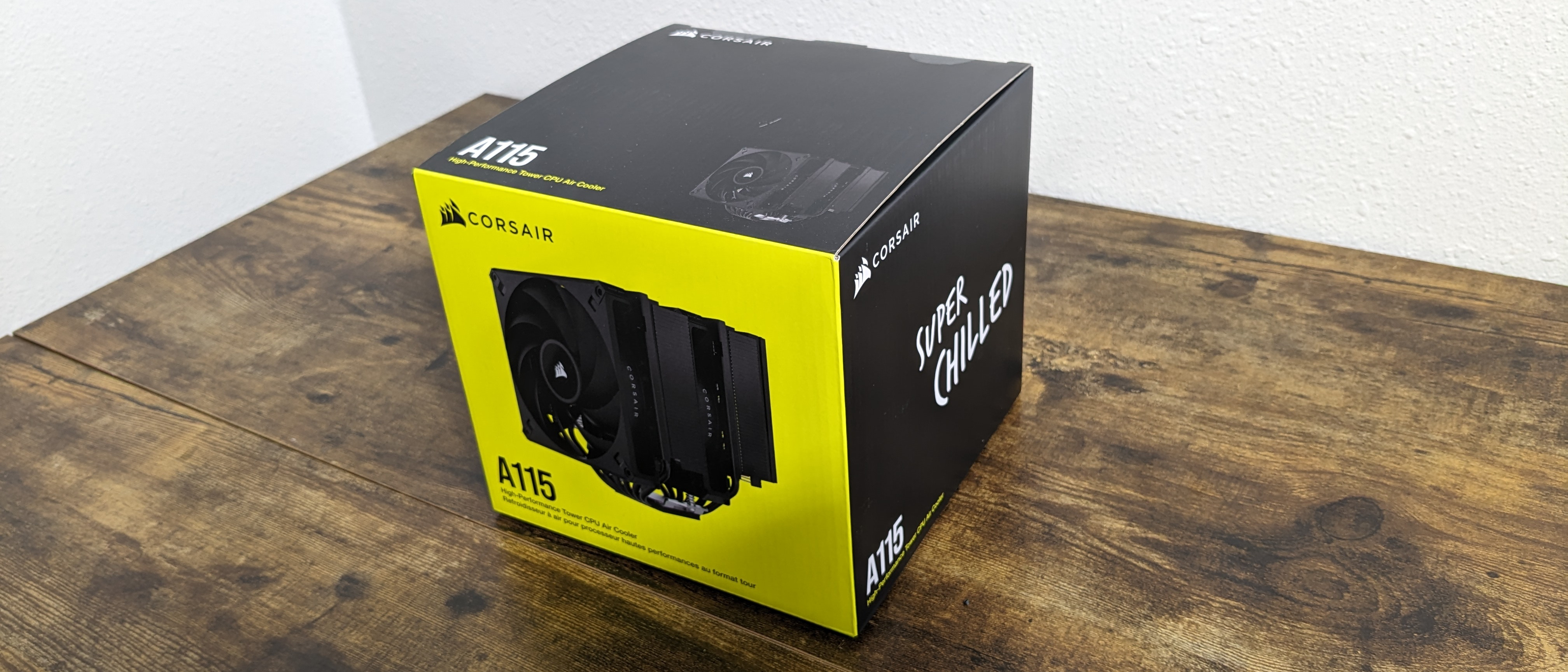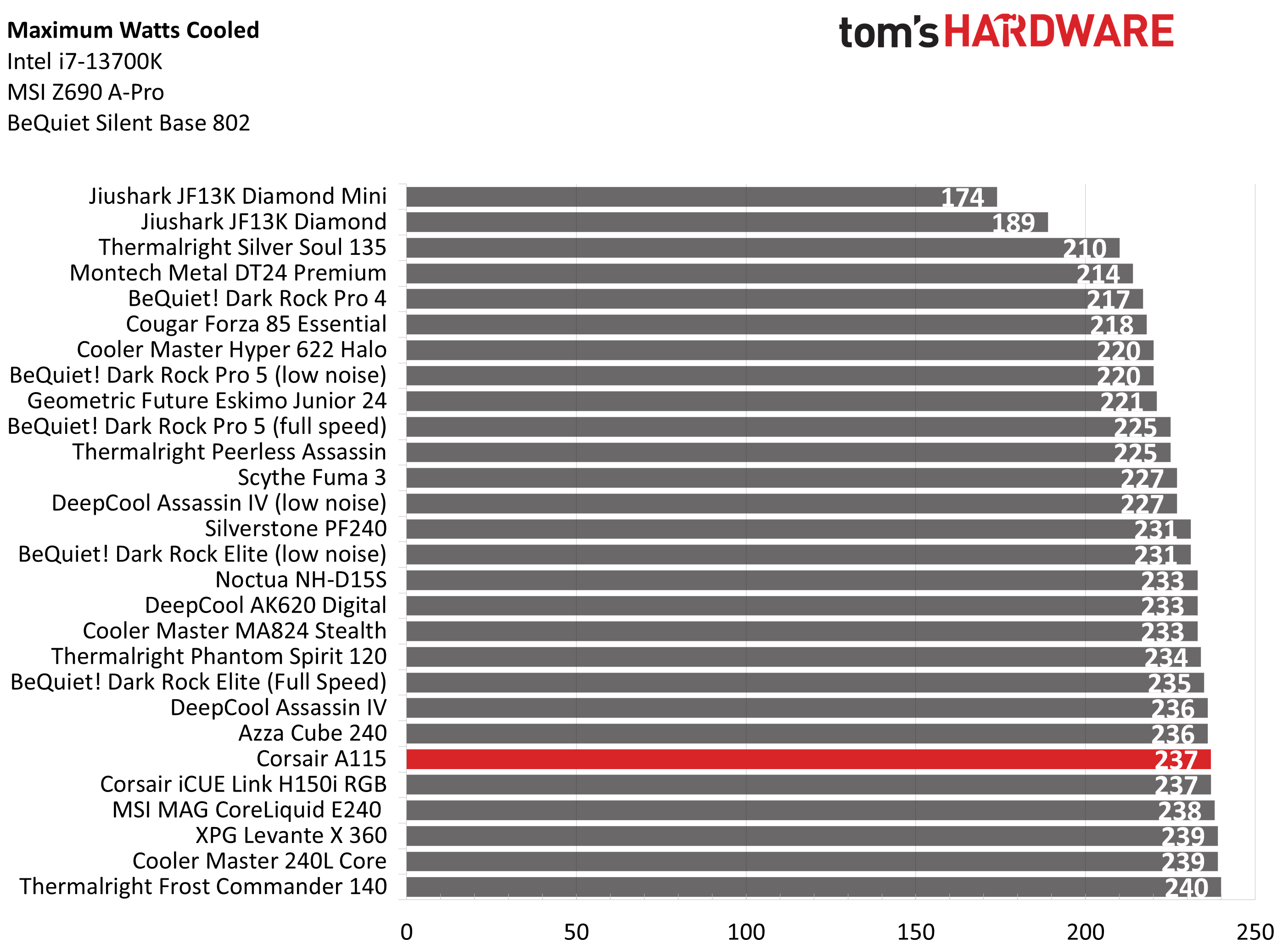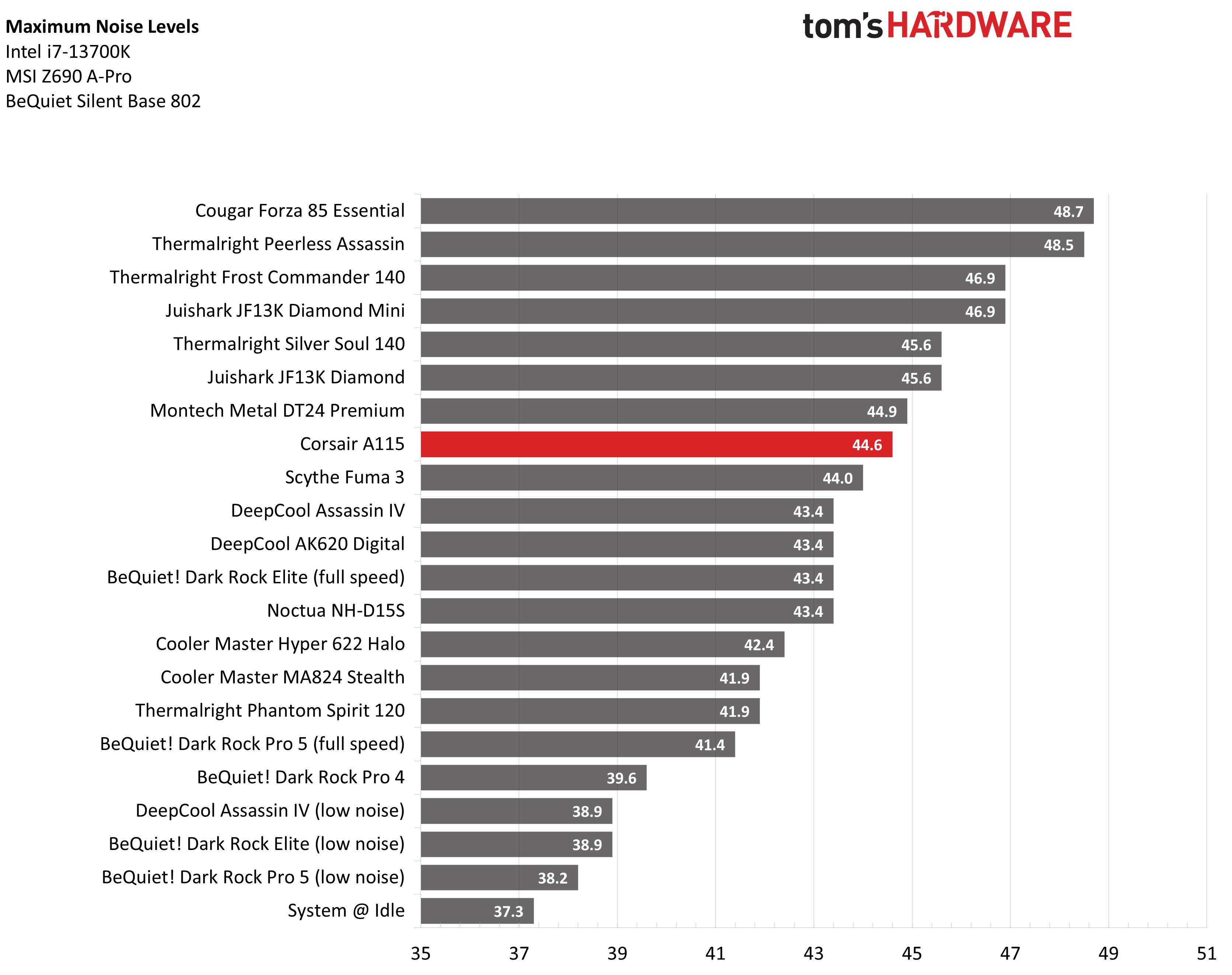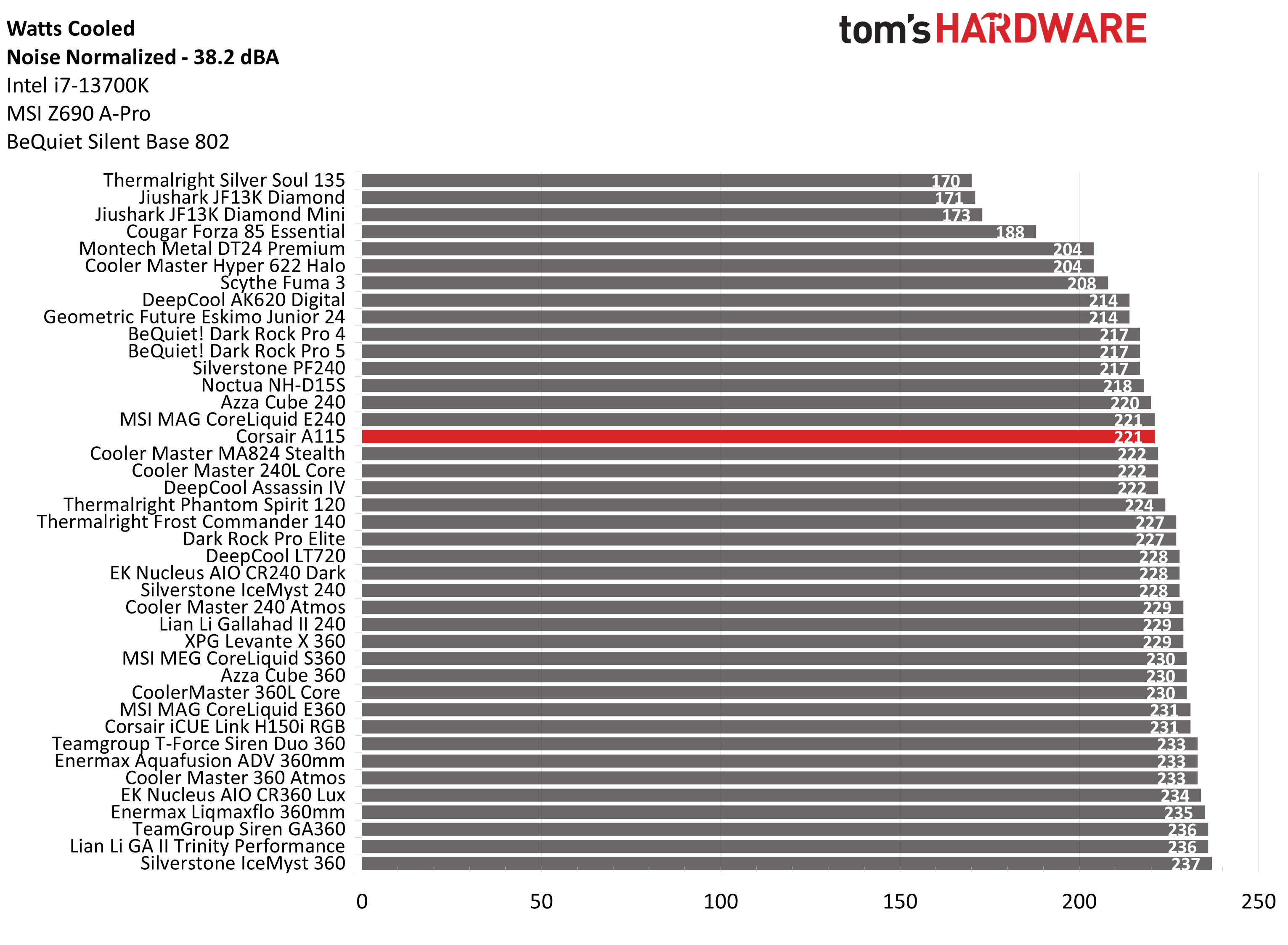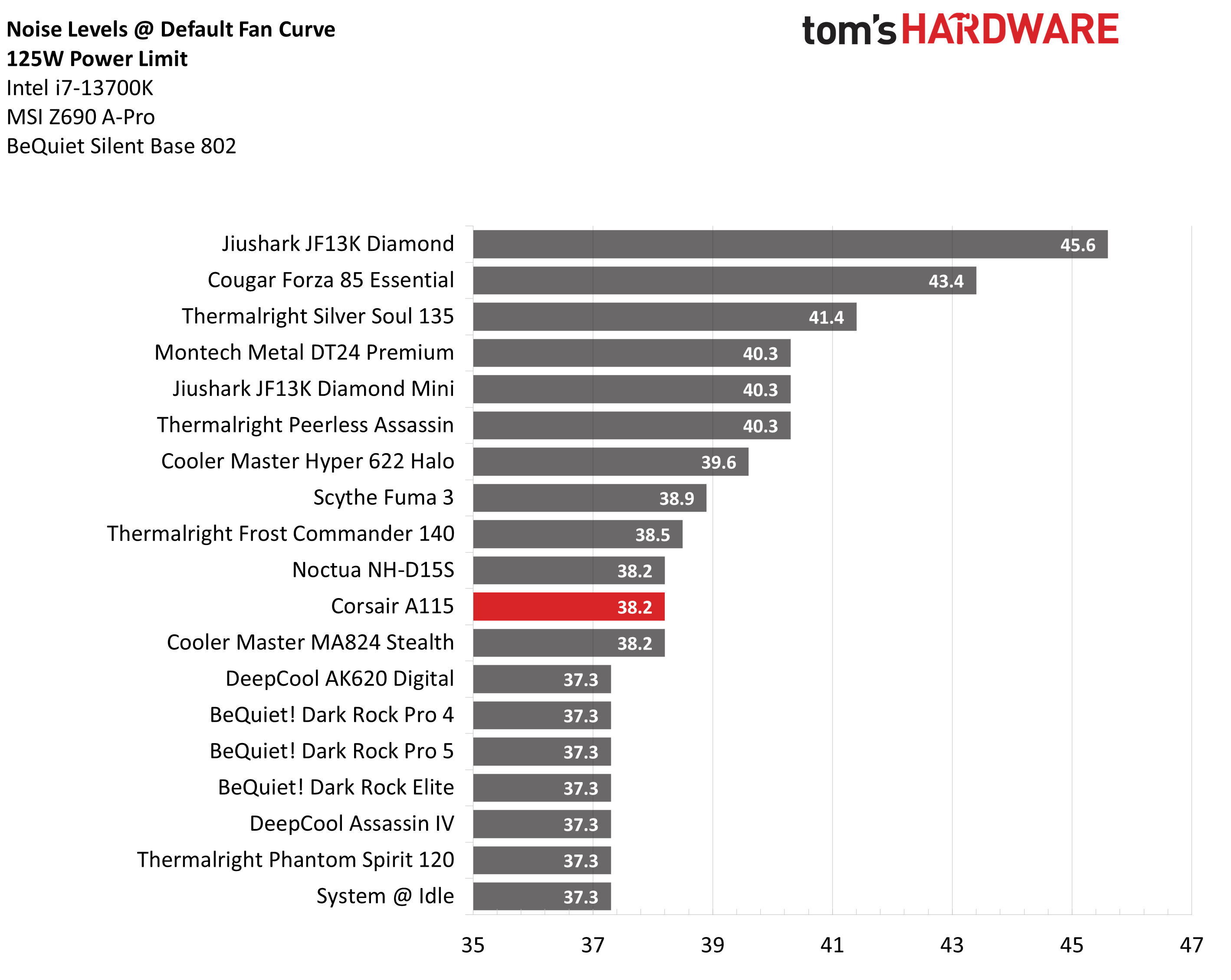Why you can trust Tom's Hardware
Thermal results without power limits
Without power limits enforced on Intel’s i7-13700K, the CPU will hit its peak temperature and thermally throttle with even the strongest of air coolers. When the CPU reaches its peak temperature, I’ve measured the CPU package power to determine the maximum wattage cooled to best compare their performance. The results below do not include the best liquid coolers on the market, which are able to keep the CPU under TJ Max (100C).
Amongst air coolers, Corsair’s A115 is the second-strongest I have tested with my Intel i7-13700K system I use to test coolers with. This is a very good result, but in theory it could even be better - because I had to lift the fan a few mm above the top of the heatsink due to my RAM’s height. It’s possible that in other systems with shorter RAM the A115 might have even stronger performance and potentially match the cooling of Thermalright’s Frost Commander 140.
To achieve this level of performance, the unrestricted fans run up to 44.6 dBA. This is just a little bit louder than Noctua’s NH-D15 and BeQuiet’s Dark Rock Elite, which run at 43.4 dBA. It’s an audible noise level, but this level of loudness doesn’t bother me personally. However, each person is different and users who are very particular about acoustics may not enjoy this level of noise.
Thermal results with noise normalized to 38.2 dBA
Finding the right balance between fan noise levels and cooling performance is important. While running fans at full speed can improve cooling capacity to some extent, the benefits are limited and many users prefer a quiet system. With this noise-normalized test, I’ve set noise levels to 38.2 dba. This level of noise is a low volume level, but slightly audible to most people.
While most of the results in this review will focus on air coolers, the noise-normalized results here also show the best AIOs on the market.
With an average of 221W cooled during the course of testing, I was slightly disappointed with this result. This isn’t a bad result per se; it’s on par with many of the best air coolers on the market, like DeepCool’s Assassin IV and Cooler Master’s MA824 Stealth – but this result is beaten by Thermalright’s Frost Commander and Be Quiet’s Dark Rock Pro Elite.
175W Cinebench results
Most coolers on the market can keep Intel’s i7-13700K under its peak temperature if the power consumption is limited. So for this test, we’ll be looking at the CPU’s actual temperature.
Get Tom's Hardware's best news and in-depth reviews, straight to your inbox.
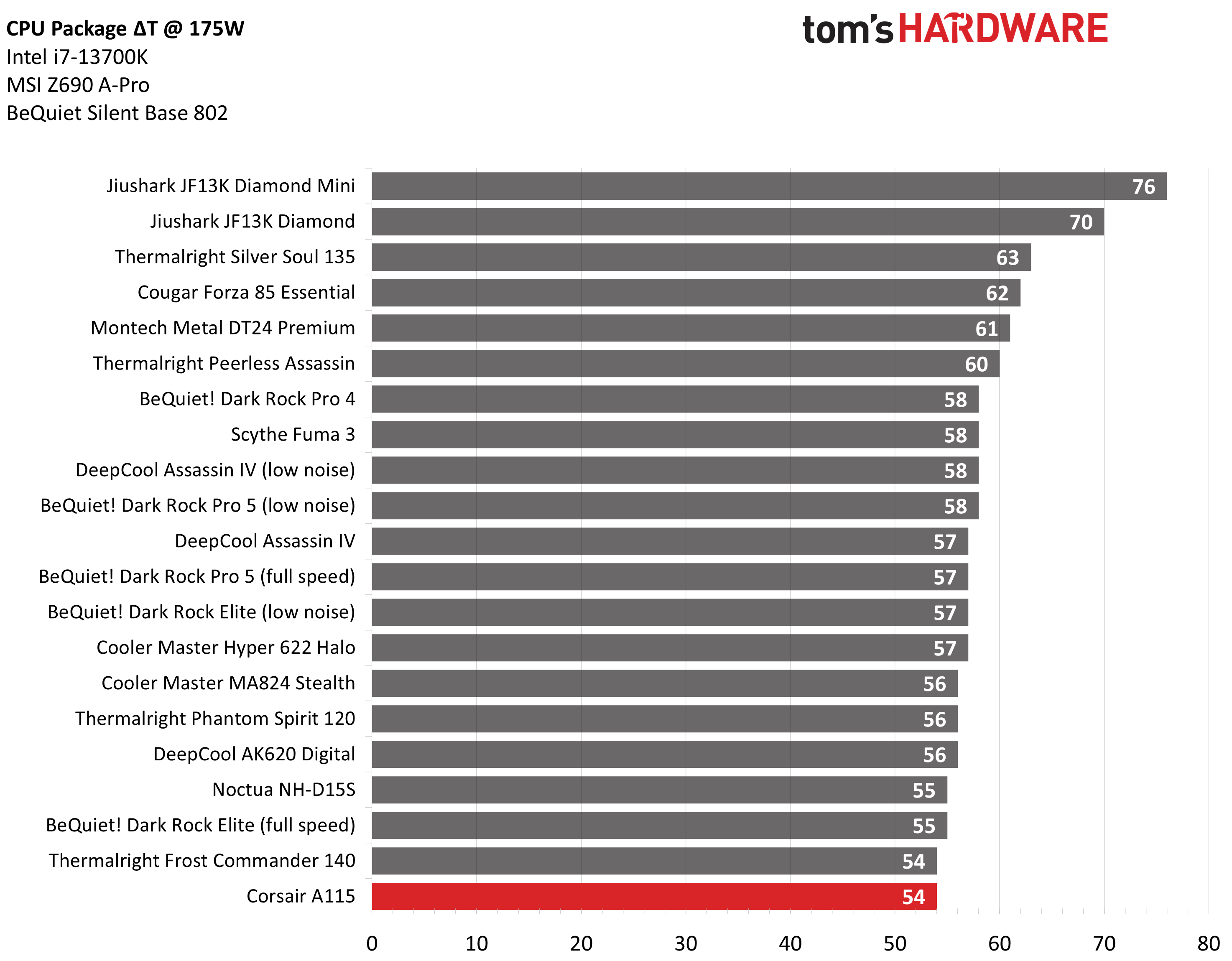
Corsair’s A115 dominated our results here, tying with Thermalright’s Frost Commander 140 for the strongest result we’ve seen in this benchmark. What makes this result even more impressive is that it achieves this level of performance while running 3.2 dBA quieter than Thermalright’s Frost Commander, with a noise level of only 41.4 dBA.
125W Cinebench results
The lowest power limit I test with Raptor Lake CPUs is 125W. This is a high enough limit to allow the CPU to maintain its base clock speeds even in the most intensive tests, and most coolers should be capable of keeping the CPU below TJ max (the max temperature before throttling) – even low-end coolers.
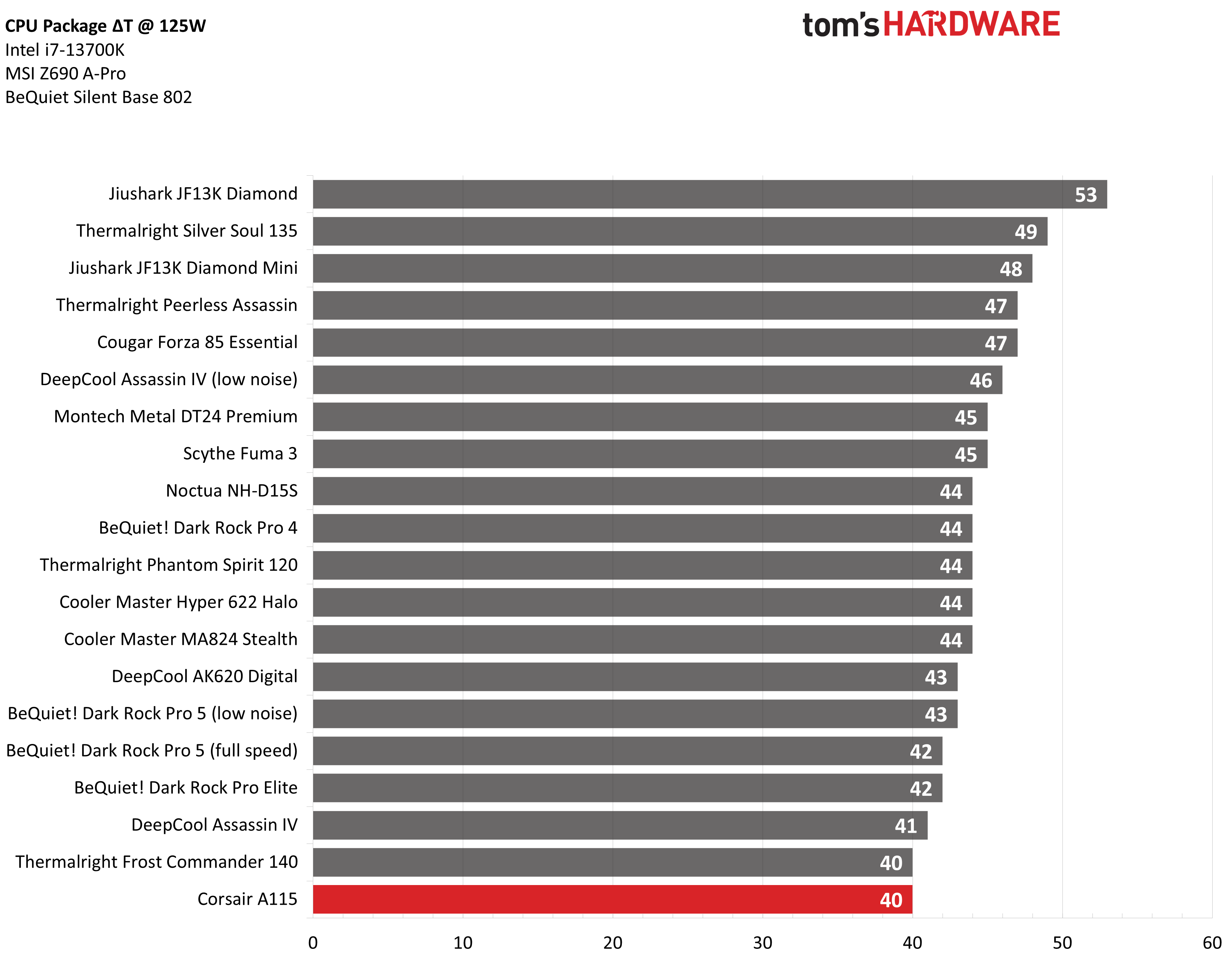
Really, thermals do not matter in this scenario. Even Intel’s stock cooler can handle a load like this with ease. Noise levels, rather than CPU temperature, are the most important factor here. That being said, Corsair’s A115 once again dominated our thermal performance with the best result of any air cooler we’ve seen, tying with Thermalright’s Frost Commander with a temperature of 40 degrees C over ambient. It achieves this level of performance while running at 38.2 dBA when tied to the default fan curve of my MSI Z690 A Pro motherboard. This is amongst the quietest results for this scenario.
Conclusion
Corsair’s new Air A115 dominates our thermal benchmarks and runs quietly. And its fan slider system makes installation a bit easier. When you consider all of the factors including noise, this is truly one of the best air coolers I’ve had the pleasure of testing.
But at $100, it faces stiff competition from coolers that are nearly as good. Thermalright’s Frost Commander 140, for instance, is certainly louder under default fan curves and maximum noise levels, but it cools basically just as well as the Corsair in our tests, and sells for around $42. So unless you need the lowest noise levels with your high-end air-cooled performance, you can save a lot of money by opting for Thermalright’s cooler. Granted, you’ll also lose the fan sliders and have to deal with old-school clips. But for a lot of people, that’s probably worth saving around $58.

Albert Thomas is a contributor for Tom’s Hardware, primarily covering CPU cooling reviews.
-
dmitche3 "The cooler arrives in a large-ish box, with the contents protected by cardboard, molded foam, and plastic." I don't know about you but this sold me. Can't wait to get that box! AND with molded foam. It sells chills down my spine.Reply -
Tom Sunday In this case: My immediate reaction and 'buying decision making' would be in purchasing from NOCTUA. It’s not exactly that Corsair with the Air A115 has any new cooling rabbits or truly noteable cooling improvements in their black hat. Corsair here is essentially just regurgitating a proven dual-tower heatsink design which in principal has been around for many years past. And duplicated and proffered by dozens of other OEMs. The Air A115 also lists within in the $100 pricing range which for Corsair being a non OEM or just a basic component distributor, is exceedingly high and overpriced. I am also not sure why the review made such a big deal about the packaging…large box, molded foam and plastic not withstanding?Reply -
Albert.Thomas Guys,Reply
I briefly cover the packaging of every cooler I test. This ain't anything new. -
stewartwb Thermalright Phantom Spirit 120 for the win! Per this review, 1dBA quieter than the Corsair A115 at default fan curve. Within spitting distance on thermals (Only 0.5ºC warmer CPU temp at 175W limit.)Reply
Sliding brackets are cool, but 2.5 times the price? Really? Cost $41 in October 2023. Quietest cooler I've ever owned, even when encoding video on my Ryzen X5700. About as quiet as my son's Arctic Liquid Freezer II 280 AIO cooler. -
thestryker While the big expensive coolers do a really good job I feel like Thermalright has done a number on them. Thermalright is so much less expensive that it narrows an already narrow use case for them. Barring some sort of aesthetic (or brand preference, which I find silly, but understand everyone's different) preference I don't see why you would buy anything else prior to making the jump to AIO/custom loop cooling.Reply -
Amdlova Reply
I Got some dual tower cooler with some bend because some people tend to play soccer with the package.dmitche3 said:"The cooler arrives in a large-ish box, with the contents protected by cardboard, molded foam, and plastic." I don't know about you but this sold me. Can't wait to get that box! AND with molded foam. It sells chills down my spine. -
Tom Sunday ReplyAlbert.Thomas said:Guys,
I briefly cover the packaging of every cooler I test. This ain't anything new.
I agree with your packaging remark. No problem. But here is one for you. Times have a way of flying away from us! Not to forget that Scythe introduced the Mugen-2 CPU cooler 15 years ago. Advertised with excellent cooling performance, excellent workmanship, easy assembly and a super low price. WOW…the Mugen 2 had 'five separate cooling towers' and was then fundamentally very different from anyhing on the market at the time. Scythe attached great importance to the workmanship of the cooler, which was evident, for example, in the cleanly executed fin towers, the nickel-plated and perfectly flat copper base plate or the heat pipe end pieces. There were also changes to the mounting system of the Mugen 2. Instead of the comfortable push-pin system which is not suitable for heavier coolers, Scythe used a backplate and one of the industries first for mounting the Mugen 2.
Even under fair testing conditions the Mugen 2 was able to assert itself as the third most air powerful cooler in the testing line-ups. Even the somewhat more complicated assembly had its reasons and was preferable to a simpler and therefore less safe method. For me personally the Mugen 2 design format came very close in appearance and purpose to the much later introduced Noctua NH-P1 format and for the tower to do all of the heavy lifting. Except that Scythe threw-in and extra fan for good measure. Will history perhaps repeat itself?
